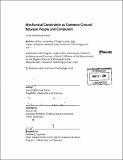Mechanical constraints as common ground between people and computers
Author(s)
Patten, James McMichael, 1977-
DownloadFull printable version (18.85Mb)
Other Contributors
Massachusetts Institute of Technology. Dept. of Architecture. Program In Media Arts and Sciences
Advisor
Hiroshi Ishii.
Terms of use
Metadata
Show full item recordAbstract
This thesis presents a new type of human-computer interface based on mechanical constraints that combines some of the tactile feedback and affordances of mechanical systems with the abstract computational power of modern computers. The interface is based on a tabletop interaction surface that can sense and move small objects on top of it. Computation is merged with dynamic physical processes on the tabletop that are exposed to and modified by the user in order to accomplish his or her task. The system places mechanical constraints and mathematical constraints on the same level, allowing users to guide simulations and optimization processes by constraining the motion of physical objects on the interaction surface. The interface provides ample opportunities for improvisation by allowing the user to employ a rich variety of everyday physical objects as interface elements. Subjects in an evaluation were more effective at solving a complex spatial layout problem using this system than with either of two alternative interfaces that did not feature actuation.
Description
Thesis (Ph. D.)--Massachusetts Institute of Technology, School of Architecture and Planning, Program in Media Arts and Sciences, 2006. Includes bibliographical references (p. 143-149).
Date issued
2006Department
Program in Media Arts and Sciences (Massachusetts Institute of Technology)Publisher
Massachusetts Institute of Technology
Keywords
Architecture. Program In Media Arts and Sciences